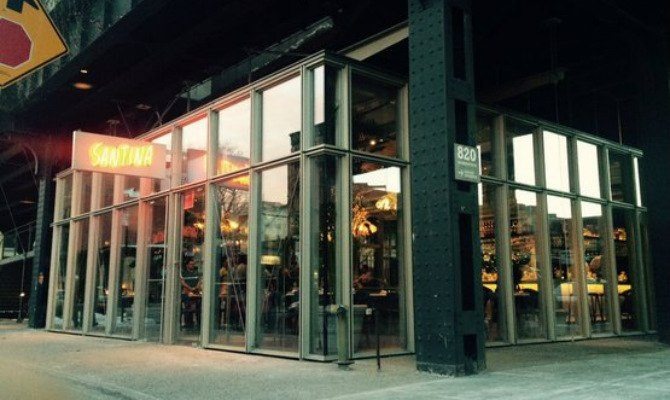Santina Awarded Two Stars By Pete Wells
This week, New York Times restaurant critic Pete Wells reviewed Santina, the latest endeavor from the Major Food Group — the gentlemen behind CARBONE, Dirty French, Parm, and ZZ's Clam Bar. Just as he did to Dirty French back in December, he gave its corporate sibling two stars.
Wells describes Santina as an oasis from the bitter cold of January, when he visited what must have been just days after it opened. He was pleased by the year-round summer vibe the eatery exudes through its décor ("Santina's new glass-box building sits under the High Line like an unwisely located greenhouse, but oranges grew on the branches of a little tree, potted palms sat in the corners, heliconia and other tropical flowers gushed from glazed urns above the bar"), the servers' dress code ("Servers wore jelly-bean-colored polo shirts and slim-waisted chinos, like Dean Martin reaching for his 9-iron at Pebble Beach"), and, of course, the food ("Almost all the food at Santina pulses with the bright, refreshing flavors we crave in hot weather and, it turns out, in other months, too"). He recommends the "Cecina; giardinia crudité; squash carpaccio; radish and salmon; house anchovies; minestrone; shrimp zingara; guajillo chicken; swordfish dogana; eggplant sesame; spicy potatoes; [and] grapefruit Italian ice."
Why no third star? In this review, the critic was clear about where Santina misses the mark. Wells admits that the plates chefs Carbone and Haar create are "fairly complex stuff," which is why they suffer when "occasionally a heavy hand gets the better of the kitchen and the summer sun turns oppressive. Blue crab meat with spaghetti became mired in an oily glop of tomato sauce, and excess pork fat dragged down a bowl of warm rice salad tossed with guanciale and heaps of black pepper. Sea bass Agrigento, though cooked just right and buoyed by herbs and orange sections, sank under suffocating amounts of red peppers." The opposite is true with the desserts, which puzzles the critic, who muses that they "almost seem underthought... the pastry tubes are limp. So is the tart shell... All the desserts are gluten-free, a worthwhile goal, but the substitutions entail more sacrifice than they probably should. The meringue puff topped with lime custard is very good, but it could use company."
As always, Wells leaves us bit perplexed by his secret methodology, as it seems to us that this is exactly the type of the overwrought dining experience — the kind that has become nearly ubiquitous in the Meatpacking District — the critic disdains. Tommy Bahama-esque uniformed staff? Drinks served in porcelain pineapples? This is so not what we thought his deal is (nor, can we say, is it ours). In fact, what left us most confused was his somewhat contradictory description of the venue. While toward the beginning, Wells tells us that "Even when the front doors opened, the building is so painstakingly designed by the architect Renzo Piano (with the firm Beyer Blinder Belle) that its vestibule kept the cold winds of the meatpacking district from invading the dining room," toward the end of the review, he states that you'll be happy once you're through with your meal "if the noise ricocheting off the glass walls hasn't gotten to you," and dubs the sound level inside as "Oppressive at peak capacity." Major Food Group is known to play their music at extreme volumes throughout their venues, and we have been regaled with stories of staff flat-out refusing to lower the pumping beats. The thought of this scenario combined with the high-ceilinged glass structure, gimmicky cocktails, and lackluster desserts does not conjure images of paradise — in fact, we think this closely describes the exact opposite. I guess we'll just have to save up a ticket to the real thing.
